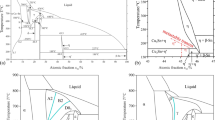Conclusions
Different types of inclusions have various effects on the type of microstructure formed. Sulfides are the most active. Corundum and carbides affect the structure to a lesser extent than sulfides.
Relatively large sulfide inclusions, with an expansion coefficient differing from that of the base metal, create stress fields during cooling (heating), inducing the formation of lattice defects visible as etch pits and subboundaries.
Similar content being viewed by others
Additional information
Translated from Metallovedenie i Termicheskaya Obrabotka Metallov, No. 9, pp. 43–44, September, 1970.
Rights and permissions
About this article
Cite this article
Leshchinskaya, R.P., Samartseva, G.P. Nonmetallic inclusions in alloys of the YuNDK24 type. Met Sci Heat Treat 12, 761–762 (1970). https://doi.org/10.1007/BF00652728
Issue Date:
DOI: https://doi.org/10.1007/BF00652728




